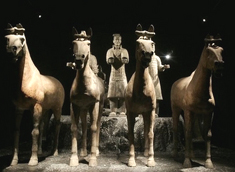
Age-old Chinese?warriors have come back to figurative life
in a major new exhibition in Rome that started on Friday, one of
the most keenly awaited shows in the capital this autumn.
The striking terra-cotta figures are from the "army" of
life-sized warriors, horses and chariots found near the mausoleum
of Qin Shi Huangdi, the first emperor of a united China in the
third century BC.
"We have tried to bring these statues, destined never to be seen
again, back to life," said curator Maurizio Scarpari.
"They have become imbued with extraordinary force," Scarpari
went on, stressing the enthusiastic response to the show of the
governor of China's Shaanxi Province, which loaned the famed
figures.
As well as the warriors, burial garments embroidered with jade
and golden threads are among the star attractions of the show,
which covers 1,000 years of Chinese imperial life - "the most
splendid period in the history of the Celestial Empire," Scarpari
said.
On display are some 320 artifacts, some of which have never left
China, from 13 museums.
The exhibition, which runs from September 22 to January 28, is
entitled "China: The Birth of an Empire."
Italian President Giorgio Napolitano, who visited the show
before it opened Friday, said it was "fantastic."
It underscored the thousand-year-old friendship between Italy
and China, sparked by such trail-blazing figures as Marco Polo and
the Jesuit priest Matteo Ricci, said the president.
(Xinhua News Agency, Associated Press?September 23,
2006)?
?

